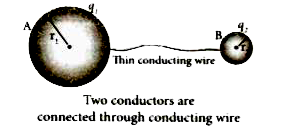Explain in detail how charges are distributed in a conductor and the principle behind the lightning conductor. Solution in Tamil
Distribution of charge in a conductor : Consider two conducting spheres A and B of radii r1 and r2 respectively connected to each other by a thin conducting wire as shown in the figure . The distacne between the spheres is much greater than the radii of either spheres.

If a charge Q is introduced into any one of the spheres this charge Q is redistributed into both the spheres such that the electrostatic potential is same in both the spheres . They are now uniformly charged and attain electrostatic equilibrium . Let q1 be the charge residing on the surface of sphere A and q2 is the charge residing on the surgace of sphere B such that Q=q1+q2 . The charges are distributed only on the surface and there is no net charge inside the conductor . The electrostatic potential at the surface and there is no net charge inside the conductor . The electrostatic potential at the surface of the sphere A is given by
VA=14ε0q2r2
The electrostatic potential at the surface of the sphere B is given by
VB=14πε0q2r2
The surface of the conductor is an equipotential. since the spheres are connected by the conducting wire the surface of both the spheres together form an equipotential surface . This implies that
VA=VBor q1r1=q2r2
Let us take the charge density on the surface of sphere A is σ1 and charge density on the surface of sphere B is σ2 . This implies that q1=4πr21σ1 and q2=4πr22σ2. Substituting these values into equation (3) we get
σ1r1=σ2r2
from which we conclude that σr = constant
Thus the surface charge σ is inversely proportional to the radius of the sphere . For a smaller radius the charge density will be larger and vice versa.
Lightning arrester or lightning conductor : This is a device used top protect tall buildings from lightning strikes . It works on the principle of action at points or corona discharge. The device consists of a long thick copper rod passing from top of the building to the ground . The upper end of the rod has a sharp spike or a sharp needle. The lower end of the rod is onnected to the copper plate which is buried deep into the ground . When a negatively charged cloud is passing above the building it induces a positive charge on the spike. Since the induced charge density on thin sharp spke is large it results in a corona discharge. This positive charge ionizes the surrounding air which in turn neutralizes the negative charge in the cloud. The negative charge pushed to the spikes passes through the copper rod and is safely diverted to the Earth . The lightning arrester does not stop the lightning rather it divers the lightning to the groung safety.
Topper's Solved these Questions
- BOOK - FULL MARKSCHAPTER - ELECTROSTATICS EXERCISE - EXERCISES15videos
ELECTROSTATICS
- BOOK - FULL MARKSCHAPTER - ELECTROSTATICS EXERCISE - ADDITIONAL QUESTIONS SOLVED ( Multiple choice questions : )57videos
ELECTROSTATICS
- BOOK - FULL MARKSCHAPTER - ELECTROSTATICS EXERCISE - Textual Evaluation Solved (II. Short Answer Questions : )21videos
ELECTROSTATICS
- BOOK - FULL MARKSCHAPTER - DUAL NATURE OF RADIATION AND MATTEREXERCISE - ADDITIONAL QUESTIONS -( ADDITIONAL NUMERICAL PROBLEMS : )10videos
DUAL NATURE OF RADIATION AND MATTER
- BOOK - FULL MARKSCHAPTER - MAGNETISM AND MAGNETIC EFFECTS OF ELECTRIC CURRENT EXERCISE - ADDITIONAL QUESTIONS SOLVED - NUMERICAL PROBLEMS :4videos
MAGNETISM AND MAGNETIC EFFECTS OF ELECTRIC CURRENT
Similar Questions
When two objects are rubbed with each other approximately a charge of 50 nC can be produced in each object . Calculate the number of electrons that must be transferred to produce this charge.
01:02:14View SolutionWhen a slide body is negatively charged by friction, it means that the body has
01:38View SolutionWhat is meant by quantisation of charges ?
01:35View SolutionIf a light of wavelength 4950 Å is viewed as a continuous flow of photons, what is the energy of each photon in eV ? (Given h=6.6×10−34Js, c =3×108ms−1)
03:03View SolutionThe radius of the first orbit of hydrogen atom is 0.5 Å. The electron moves is an orbit with a uniform speed of 2.2×106ms−1. What is the magnetic field produced at the centre of the uncleus due to the mation of this electron ? Use μ0=4π×10−7Hm−1 and electric charge =1.6×10−19 C
02:58View SolutionConductor,Distribution Of Charge)
01:17:20View Solutionतड़ित चालक की क्रिया के दो सिद्धांत बताइये।
46:11View Solutionतड़ित चालक तड़ित से भवन की .......... करता है।
01:01:49View SolutionOn what principle does a lightning conductor work?
01:36View SolutionWhat is lightning conductor? Explain its composition. How does it protect the house from lightning?
01:15View SolutionConductor-Charge Distribution
02:08View SolutionConductor||Distribution of Charge||Lightining Conductor
01:14View SolutionConductors||Distribution OF charges
01:36View SolutionLightning conductor works on the principle of charging by ................ (induction/conduction)
View SolutionHow does a lightning conductor protect buildings from lightning?
03:40View Solution
